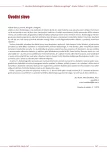Percutaneous coronary interventions in diabetic patients
Authors:
J. Šťásek
Authors‘ workplace:
I. interní klinika Lékařské fakulty UK a FN Hradec Králové, přednosta prof. MU Dr. Jan Vojáček, DrSc., FESC, FACC
Published in:
Vnitř Lék 2010; 56(4): 320-323
Category:
11th National Diabetes Symposium "Diabetes and Angiology", Hradec Kralove, 5 to 6 June 2009
Overview
Diabetes mellitus (DM) is a serious medical problem. The patients with diabetes have higher risk of coronary artery diseases. Diabetes mellitus also increases the risk of complication resulting from revascularization treatment in compare with non-diabetic patients. The first studies, which compare the surgical and percutaneous revascularization proved, that the major difference between these two revascularization techniques is in patients with diabetes. The difference is inflected by necessity of repeated revascularization after PCI, which is caused by higher incidence of a restenosis in patients with DM. Mortality, myocardial infarction and stroke are more frequent in diabetic patients, but the difference between PCI and surgical treated groups is not significant. Though the restenosis had significantly decreased due to of drug-eluted stents, the surgical revascularization is preferred method of treatment in patients with insulin-dependent diabetes, poorly compensated diabetes and patients with multiple complex coronary disease.
Key words:
diabetes mellitus – percutaneous coronary revascularisation – aorto- coronary bypass – stent – drug‑eluted stent
Sources
1. Expert Panel on Detection, Evaluation, and Treatment of High Blood Cholesterol in Adults. Executive Summary of the Third Report of the National Cholesterol Education Program (NCEP) Expert Panel on Detection, Evaluation, and Treatment of High Blood Cholesterol In Adults (Adult Treatment Panel III). JAMA 2001; 285: 2486– 2497.
2. Haffner SM, Lehto S, Rönnemaa T et al. Mortality from coronary heart disease in subjects with type 2 diabetes and in nondiabetic subjects with and without prior myocardial infarction. N Engl J Med 1998; 339: 229– 234.
3. Malmberg K, Yusuf S, Gerstein HC et al. Impact of diabetes on long‑term prognosis in patients with unstable angina and non‑Q‑ wave myocardial infarction: results of the OASIS (Organization to Assess Strategies for Ischemic Syndromes) Registry. Circulation 2000; 102: 1014– 1019.
4. Yusuf S, Zucker D, Peduzzi P et al. Effect of coronary artery bypass graft surgery on survival: overview of 10‑year results from randomised trials by the Coronary Artery Bypass Graft Surgery Trialists Collaboration. Lancet 1994; 344: 563– 570.
5. Comparison of coronary bypass surgery with angioplasty in patients with multivessel disease. The Bypass Angioplasty Revascularization Investigation (BARI) Investigators. N Engl J Med 1996; 335: 217– 225.
6. Serruys PW, Unger F, Sousa LF et al. Arterial Revascularization Therapies Study Group. Comparison of coronary‑ artery bypass surgery and stenting for the treatment of multivessel disease. N Engl J Med 2001; 344: 1117– 1124.
7. Abizaid A, Costa MA, Centemero M et al. Arterial Revascularization Therapy Study Group. Clinical and economic impact of diabetes mellitus on percutaneous and surgical treatment of multivessel coronary disease patients: insights from the Arterial Revascularization Therapy Study (ARTS) trial. Circulation 2001; 104: 533– 538.
8. Serruys PW, Ong AT, van Herwerden LA et al. Five‑year outcomes after coronary stenting versus bypass surgery for the treatment of multivessel disease: the final analysis of the Arterial Revascularization Therapies Study (ARTS) randomized trial. J Am Coll Cardiol 2005; 46: 575– 581.
9. Daemen J, Boersma E, Flather M et al. Long‑term safety and efficacy of percutaneous coronary intervention with stenting and coronary artery bypass surgery for multivessel coronary artery disease: a meta‑analysis with 5‑year patient‑ level data from the ARTS, ERACI‑ II, MASS‑ II, and SoS trials. Circulation 2008; 118: 1146– 1154.
10. Moreno PR, Murcia AM, Palacios IF et al. Coronary composition and macrophage infiltration in atherectomy specimens from patients with diabetes mellitus. Circulation 2000; 102: 2180– 2184.
11. Ehtisham M. Meta‑analysis of DES in diabetic data. EuroPCR 2007.
12. Stenestrand U, James SK, Lindbäck J et al. SCAAR/ SWEDEHEART study group. Safety and efficacy of drug‑eluting vs. bare metal stents in patients with diabetes mellitus: long‑term follow‑up in the Swedish Coronary Angiography and Angioplasty Registry (SCAAR). Eur Heart J 2010; 31: 177– 186.
13. Serruys PW, Lemos PA, van Hout BA. Arterial Revascularisation Therapies Study part II Steering Committee and Investigators. Sirolimus eluting stent implantation for patients with multivessel disease: rationale for the Arterial Revascularisation Therapies Study part II (ARTS II). Heart 2004; 90: 995– 998.
14. Serruys PW, Morice MC, Kappetein AP et al. SYNTAX Investigators. Percutaneous coronary intervention versus coronary‑ artery bypass grafting for severe coronary artery disease. N Engl J Med 2009; 360: 961– 972.
15. Serruys PW, Onuma Y, Garg S et al. Assessment of the SYNTAX score in the Syntax study. EuroIntervention 2009; 5: 50– 56.
16. Javaid A, Steinberg DH, Buch AN et al. Outcomes of coronary artery bypass grafting versus percutaneous coronary intervention with drug‑eluting stents for patients with multivessel coronary artery disease. Circulation 2007; 116 (Suppl 11): 1200– 1206.
17. Qiao Y, Ma C, Nie S et al. Twelve monthsclinical outcome of drug‑eluting stents implantation or coronary artery bypass surgery for the treatment of diabetic patients with multivessel disease. Clin Cardiol 2009; 32: E24– E30.
18. Stone GW, Midei M, Newman W et al. SPIRIT III Investigators. Randomized comparison of everolimus‑eluting and paclitaxel‑eluting stents: two‑year clinical follow‑up from the Clinical Evaluation of the Xience V Everolimus Eluting Coronary Stent System in the Treatment of Patients with de novo Native Coronary Artery Lesions (SPIRIT) III trial. Circulation 2009; 119: 680– 686.
19. Stone GW. SPIRIT IV: Xience V trumps Taxus for clinicly driven end points, although diabetic questions linger. San Francisco, TCT Conference 2009.
Labels
Diabetology Endocrinology Internal medicineArticle was published in
Internal Medicine

2010 Issue 4
Most read in this issue
- Angiopathy and the eye
- Peripheral arterial disease and diabetes
- Surgical treatment of ischemic heart disease and diabetes mellitus
- Diabetes mellitus and ischemic heart disease
